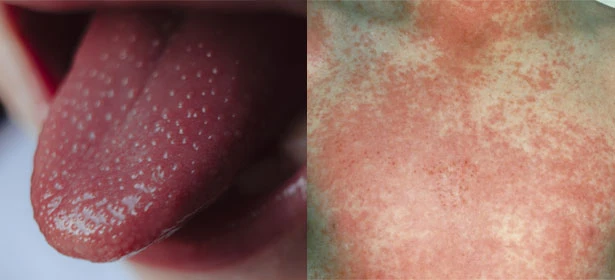Opening Times | Patient Access | Contact Us
CQC Rating Good
Scarlet Fever and iGAS Update
The latest data from the UK Health Security Agency (UKHSA) shows that scarlet fever cases continue to remain higher than we would typically see at this time of year.
Below are the main points of information, and additional advice to patients.
Scarlet fever
Scarlet fever is usually a mild illness, but it is highly infectious, and is much more common in children than adults. There were 851 cases of Scarlet Fever reported in the UK in week 46 [November 15th to 21st] compared to an average of 186 for the preceding years.
In essence it is tonsillitis accompanied by a rash.
Look out for the symptoms:
- Sore throat
- Headache
- Fever
- A fine, pinkish or red body rash with a sandpapery feel. On darker skin, the rash can be more difficult to detect visually but will have a sandpapery feel.
- The lips and tongue are often also inflamed ‘strawberry tongue'.

What to do if you suspect Scarlet Fever.
- Contact NHS 111 or your GP if you suspect scarlet fever, because early treatment of Scarlet Fever with antibiotics is important to reduce the risk of complications such as pneumonia or a bloodstream infection.
- It also reduces the risk of spreading it to other people.
- Anyone with Scarlet Fever should stay at home for at least 24 hours after the start of antibiotic treatment for this reason.
GAS (Group A Streptococcus), and iGAS (invasive Group A Streptococcal infection)
Scarlet fever is caused by GAS. These bacteria also cause other respiratory and skin infections such as tonsillitis, strep throat, impetigo and cellulitis. Group A Strep infections are usually kept within the surface layers of the body by the immune system, helped by antibiotic treatments.
In very rare occasions, the bacteria can get into the bloodstream and cause an illness called invasive Group A strep (iGAS). While still uncommon, there has been an increase in invasive Group A strep cases this year, particularly in children under 10.
There were 2.3 cases per 100,000 children aged 1 to 4 compared to an average of 0.5 in the pre-pandemic seasons (2017 to 2019) and 1.1 cases per 100,000 children aged 5 to 9 compared to the pre-pandemic average of 0.3 (2017 to 2019) at the same time of the year.
So far this season there have been 5 recorded deaths within 7 days of an iGAS diagnosis in children under 10 in England. During the last high season for Group A Strep infection (2017 to 2018) there were 4 deaths in children under 10 in the equivalent period.
Investigations are also underway following reports of an increase in lower respiratory tract Group A Strep infections [chest infections and pneumonia] in children over the past few weeks, which have caused severe illness.
Currently, there is no evidence that a new strain is circulating. The increase is most likely related to high amounts of circulating bacteria and social mixing.
Fortunately, Group A Strep continues to be sensitive to a variety of antibiotic treatments. Even if it is causing invasive infections, it is unusual for it to be resistant to antibiotics.
Frequently Asked Questions
What is Group A Streptococcus (GAS)?
Group A Streptococcus is a bacterium often found in the throat and on the skin.
How is GAS spread?
Streptococci survive in the throat and on hands for long enough to allow easy spread between people through sneezing, kissing and skin contact. People may carry Group A Streptococci in their throat or on the skin and have no symptoms of illness. This is known as being colonised.
What kinds of illnesses are caused by GAS?
Most GAS infections are relatively mild illnesses such as ‘strep throat’, or a skin infection such as impetigo. On rare occasions, these bacteria can cause other severe diseases.
What is invasive Group A Streptococcal disease (iGAS)?
Sometimes severe GAS disease may occur when bacteria get into parts of the body where bacteria are usually not found, such as the blood, muscles or the lungs. These infections are known as invasive Group A Streptococcal disease and may include serious conditions, such as toxic shock syndrome.
Why does invasive Group A Streptococcal disease occur?
Invasive GAS infections occur when the bacteria get past the defences of the person who is infected. This may occur when a person has sores or other breaks in the skin that allow the bacteria to get into the tissue, or when the person’s ability to fight off the infection is decreased because of chronic illness or an illness that affects the immune system.
Also, some strains of GAS are thought to be more likely to cause severe disease than others.
Am I at risk of getting Group A Streptococcal disease from close contact with a relative or household contact?
Most people who come into contact with GAS remain well and symptom-free or develop mild throat or skin infections.
Healthy people can get invasive GAS disease from a relative or a member of their household but it is very rare. In adults it may be more likely that the infection will start from a wound, tissue or skin infection than from a throat infection.
What does iGAS look like as an illness in children?
There are lots of viruses that cause sore throats, colds and coughs circulating. These should resolve without medical intervention. However, children can on occasion develop a bacterial infection on top of a virus and that can make them more unwell. iGAS may start with the same symptoms of tonsillitis or other local infections such as impetigo or cellulitis [skin and soft tissue infections] but the person becomes more unwell than expected as the bacteria invade into the bloodstream.
What should I do if I suspect a GAS infection in my child?
As a parent, if you feel that your child seems seriously unwell, you should trust your own judgement.
Contact NHS 111 or your GP if:
- your child is getting worse, especially if they are getting worse at a point in a viral illness when you would be expecting them to get better
- your child is feeding or eating much less than normal
- your child has had a dry nappy for 12 hours or more or shows other signs of dehydration
- your baby is under 3 months and has a temperature of 38°C, or is older than 3 months and has a temperature of 39°C or higher
- your baby feels hotter than usual when you touch their back or chest, or feels sweaty
- your child is very tired or irritable
- the symptoms don’t settle well with paracetamol or ibuprofen.Content
Call 999 or go to A&E if:
- your child is having difficulty breathing – you may notice grunting noises or their tummy sucking under their ribs
- there are pauses when your child breathes
- your child’s skin, tongue or lips are blue
- your child is floppy and will not wake up or stay awake
What symptoms do I need to be aware of in myself?
The most important thing to be aware of are the early signs and symptoms of invasive disease. These may include:
• sore throat;
• high fever;
• severe muscle aches;
• localised muscle tenderness;
• redness at the site of a wound.
What should I do if I develop any of these symptoms?
If you develop any of these symptoms, contact your GP or seek medical advice immediately. Tell your GP if you have been in contact with someone recently diagnosed with invasive Group A Streptococcal disease and that you have developed some symptoms that you are worried about.
Most people who come into contact with GAS remain well and symptom-free, or develop mild throat or skin infections. Contracting invasive GAS disease from a relative or household member is very rare.
Many thanks to the UKHSA and to NHS Ayreshire and Arran for the bulk of this information.
UPDATE ON SCARLET FEVER AND INVASIVE GROUP A STREP
Published: Dec 5, 2022
We use cookies to help provide you with the best possible online experience.
By using this site, you agree that we may store and access cookies on your device. Cookie policy.
Cookie settings.
Functional Cookies
Functional Cookies are enabled by default at all times so that we can save your preferences for cookie settings and ensure site works and delivers best experience.
3rd Party Cookies
This website uses Google Analytics to collect anonymous information such as the number of visitors to the site, and the most popular pages.
Keeping this cookie enabled helps us to improve our website.

